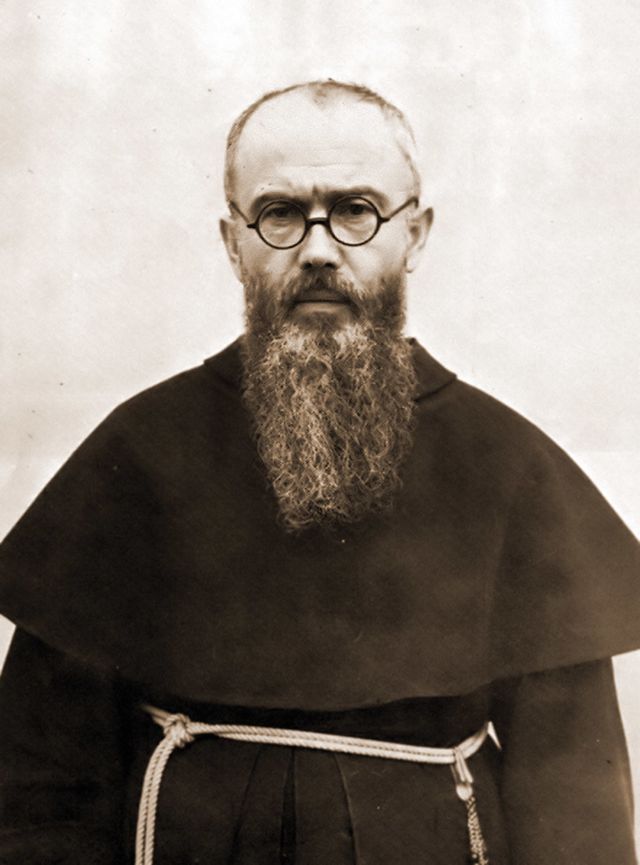Content deleted Content added
m |
|||
Line 26: | feast_day = 14 August | attributes = {{hlist | [[Religious habit|Franciscan habit]] | the ''[[Rycerz Niepokalanej]]'' | Nazi concentration prison uniform | [[Nazi concentration camp badge]] | [[crucifix]] | [[rosary]]}} | patronage = prisoners, drug addicts, families, journalists, [[amateur radio]] operators, [[pro-life movement]], people with eating disorders<ref>{{Cite web |title='I would like to take his place' – DW – 08/14/2016 |url=https://www.dw.com/en/remembering-kolbe-who-stood-up-to-nazis-at-auschwitz/a-19474219 |access-date=2023-10-22 |website=[[Deutsche Welle]] |language=en}}</ref> | issues = | suppressed_date = Line 39: '''Maximilian Kolbe''' {{post-nominals|post-noms=[[Order of Friars Minor Conventual|OFMConv]]}} (born '''Raymund Kolbe'''; {{lang-pl| Maksymilian Maria Kolbe}};{{efn|Pronounced {{IPA-pl|maksɨˌmʲilʲan ˌmarʲja ˈkɔlbɛ|}}.}} 1894–1941) was a Polish [[Catholic]] priest and [[Conventual Franciscans|Conventual Franciscan]] [[friar]] who volunteered to die in place of a man named [[Franciszek Gajowniczek]] in the German [[Extermination camp|death camp]] of [[Auschwitz concentration camp|Auschwitz]], located in [[Occupation of Poland (1939–1945)|German-occupied Poland]] during [[World War II]]. He had been active in promoting the veneration of the [[Immaculate Conception|Immaculate]] [[Blessed Virgin Mary|Virgin Mary]], founding and supervising the monastery of [[Niepokalanów]] near [[Warsaw]], operating an [[amateur radio|amateur-radio]] station (SP3RN), and founding or running several other organizations and publications. On 10 October 1982, [[Pope John Paul II]] [[canonization|canonized]] Kolbe and declared him a [[martyr of charity]].<ref>{{Cite journal|last=Kijas|first=Zdzisław Józef|date=2020|title=THE PROCESS OF BEATIFICATION AND CANONIZATION OF MAXIMILIAN MARIA KOLBE|url=http://studiaelblaskie.pl/assets/Numery/SE-tom212020.pdf#page=199|journal=Studia Elbląskie|volume=XXI|pages=199–213}}</ref> The [[Roman Catholic Church|Catholic Church]] venerates him as the [[patron saint]] of amateur radio operators, drug addicts, [[political prisoner]]s, families, journalists, and prisoners.<ref>{{Cite web |title='I would like to take his place' – DW – 08/14/2016 |url=https://www.dw.com/en/remembering-kolbe-who-stood-up-to-nazis-at-auschwitz/a-19474219 |access-date=2023-10-22 |website=[[Deutsche Welle]] |language=en}}</ref Due to Kolbe's efforts to promote [[consecration and entrustment to Mary]], he is known as an "apostle of consecration to Mary".<ref name="ArmstrongPeterson2010-51"/> Line 46: Raymund Kolbe was born on 8 January 1894 in [[Zduńska Wola]], in the [[Congress Poland|Kingdom of Poland]], which was then part of the [[Russian Empire]]. He was the second son of [[Weaver (occupation)|weaver]] Julius Kolbe and [[Midwifery|midwife]] Maria Dąbrowska.<ref name="psb296"/> His father was an [[ethnic German]],<ref name="Strzelecka1984"/> and his mother was [[Polish people|Polish]]. He had four brothers, two of whom died of tuberculosis. Shortly after his birth, his family moved to [[Pabianice]].<ref name="psb296"/> Kolbe's life was strongly influenced in 1906, when he was 12, by a vision of the [[Virgin Mary]].<ref>{{Cite book |last=Dewar |first=Diana |url=https://books.google.com/books?id=39hsAAAAIAAJ |title=Saint of Auschwitz: The Story of Maximilian Kolbe |date=1982 |publisher=Harper & Row |isbn=978-0-06-061901-5 |pages=115 |language=en}}</ref <blockquote>That night I asked the Mother of God what was to become of me. Then she came to me holding two crowns, one white, the other red. She asked me if I was willing to accept either of these crowns. The white one meant that I should persevere in purity and the red that I should become a martyr. I said that I would accept them both.<ref name="ArmstrongPeterson2010-50"/></blockquote> ==Franciscan friar== In 1907 Kolbe and his elder brother Francis joined the [[Conventual Franciscans]].<ref name=catholic-pages/> They enrolled at the Conventual Franciscan minor seminary in [[Lviv|Lwów]] later that year. In 1910, Kolbe was allowed to enter the [[novitiate]], where he chose a religious name Maximilian. He professed his [[first vows]] in 1911, and [[final vows]] in 1914,<ref>{{Cite book |last=Dewar |first=Diana |url=https://books.google.com/books?id=39hsAAAAIAAJ |title=Saint of Auschwitz: The Story of Maximilian Kolbe |date=1982 |publisher=Harper & Row |isbn=978-0-06-061901-5 |pages=36 |language=en}}</ref ===World War I=== | |||
 Article Images
Article Images